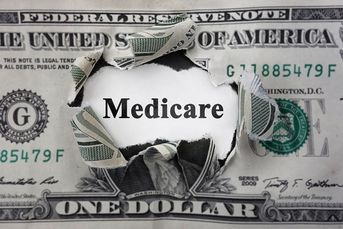How to hedge against triple whammy of Medicare price hikes
These three strategies can blunt the impact of 2016 cost increases.
The price tag for Medicare is expected to swell dramatically Jan. 1 as the result of several factors. It’s expected that:
•Medicare Part D premiums will grow 8% on average and by as much as 20% for some of the most popular Medicare prescription drug plans.
•The Medicare Part B deductible, a charge that all but the poorest beneficiaries pay, will increase 52%, from $147 to $244 per person annually.
•2016 Medicare B premiums will swell by a historically high rate of 52% for a substantial portion of beneficiaries be-cause of the lack of a Social Security COLA adjustment and the hold-harmless provisions.
To top that off, the Medicare modified adjusted gross income brackets that determine Medicare Part B and D costs for individuals with more than $85,000 or married couples with more than $170,000 MAGI will change dramatically in 2016, resulting in more people paying sizable Medicare rates effective in 2018.
That’s a triple whammy for current and soon-to-be Medicare beneficiaries.
The good news is that there are three strategies to take to blunt the impact of these Medicare cost increases:
1. This year more than ever, it pays to shop around for Medicare prescription drug coverage to make sure medications are covered in the most cost-effective manner. Whether the coverage is through a stand-alone drug plan or incorporated into a Medicare Part C (Advantage) plan, all beneficiaries are eligible to look at their options and change plans as needed during the annual enrollment period going on now through Dec. 7.
LOW-HANGING FRUIT
Plans vary down to the county and zip code level. Benefits are inconsistent with respect to which medications are covered and what the co-payments will be. As a result, 90% to 95% of individuals overpay for their Medicare prescription drug plan. This is the proverbial low-hanging fruit that can improve most Medicare beneficiaries’ balance sheets.
2. It is critically important for people to review the Social Security notice they will receive that notifies them of their 2016 Medicare B premiums and Part D higher income surcharges. Those notices will be in mailboxes soon. It’s not uncommon for people to qualify for a decrease because their income drops to a lower bracket as a result of life-changing events. For example, if a person has stopped or reduced work, resulting in a lower MAGI, he or she is eligible to apply for that lower-bracket premium.
The problem is that Social Security doesn’t know about life-changing events unless the individual notifies the agency. Qualifications for a reduction and the process to file for it are clearly outlined in that Social Security announcement. With rare exceptions, people have 60 days to file for reconsideration.
INCOME CALCULATION
3. Going forward, it is crucial to structure retirement income to maximize cash-flow sources that will not be included in Medicare’s MAGI calculation. The lower the MAGI bracket, the lower Medicare B premiums and D surcharges will be without reducing benefits.
I highly recommend incorporating tax implications when it comes to retirement planning. By doing that, investors and their financial advisers will be able to blunt the impact of Medicare B premium increases. A good place to start is to get a copy of your tax return on an annual basis. The following approaches are examples of methods that can be effective to maximize retirement cash flow that will not be included in Medicare’s MAGI calculation:
* Roth accounts, whether conversions or newly established retirement savings accounts.
* Health savings accounts are the most tax-preferred savings account in the U.S. today. HSAs provide triple benefits, as funds are contributed pre-tax, grow tax-free and are distributed with no tax as long as funds are used for health care expenses.
* Cash value life insurance.
* Some annuity proceeds.
* Reverse mortgage proceeds.
Using these three types of hedges against the rising Medicare price tag can turn the triple whammy of Medicare out-of-pocket cost growth into the trifecta of Medicare cost containment for you.
(Want to get more out of Medi-care? Download my ebook at InvestmentNews.com/medicareguide.)
Katy Votava, Ph.D., RN, is president of Goodcare.com, a consulting service that works with financial advisers and consumers concerning health care coverage.
Learn more about reprints and licensing for this article.







